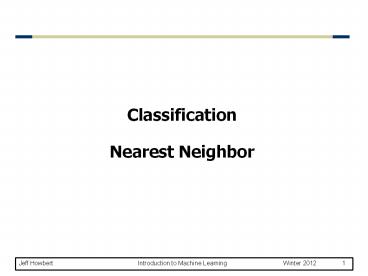Classification Nearest Neighbor - PowerPoint PPT Presentation
1 / 17
Title:
Classification Nearest Neighbor
Description:
Nearest Neighbor Instance based classifiers Store the training samples Use training samples to predict the class label of unseen samples Examples: Rote learner ... – PowerPoint PPT presentation
Number of Views:156
Avg rating:3.0/5.0
Title: Classification Nearest Neighbor
1
ClassificationNearest Neighbor
2
Instance based classifiers
- Store the training samples
- Use training samples to predict the class
label of unseen samples
3
Instance based classifiers
- Examples
- Rote learner
- memorize entire training data
- perform classification only if attributes of
test sample match one of the training samples
exactly - Nearest neighbor
- use k closest samples (nearest neighbors) to
perform classification
4
Nearest neighbor classifiers
- Basic idea
- If it walks like a duck, quacks like a duck, then
its probably a duck
5
Nearest neighbor classifiers
- Requires three inputs
- The set of stored samples
- Distance metric to compute distance between
samples - The value of k, the number of nearest neighbors
to retrieve
6
Nearest neighbor classifiers
- To classify unknown record
- Compute distance to other training records
- Identify k nearest neighbors
- Use class labels of nearest neighbors to
determine the class label of unknown record
(e.g., by taking majority vote)
7
Definition of nearest neighbor
k-nearest neighbors of a sample x are
datapoints that have the k smallest distances to x
8
1-nearest neighbor
Voronoi diagram
9
Nearest neighbor classification
- Compute distance between two points
- Euclidean distance
- Options for determining the class from nearest
neighbor list - Take majority vote of class labels among the
k-nearest neighbors - Weight the votes according to distance
- example weight factor w 1 / d2
10
Nearest neighbor classification
- Choosing the value of k
- If k is too small, sensitive to noise points
- If k is too large, neighborhood may include
points from other classes
11
Nearest neighbor classification
- Scaling issues
- Attributes may have to be scaled to prevent
distance measures from being dominated by one of
the attributes - Example
- height of a person may vary from 1.5 m to 1.8 m
- weight of a person may vary from 90 lb to 300 lb
- income of a person may vary from 10K to 1M
12
Nearest neighbor classification
- Problem with Euclidean measure
- High dimensional data
- curse of dimensionality
- Can produce counter-intuitive results
1 1 1 1 1 1 1 1 1 1 1 0
1 0 0 0 0 0 0 0 0 0 0 0
vs
0 1 1 1 1 1 1 1 1 1 1 1
0 0 0 0 0 0 0 0 0 0 0 1
d 1.4142
d 1.4142
- one solution normalize the vectors to unit
length
13
Nearest neighbor classification
- k-Nearest neighbor classifier is a lazy learner
- Does not build model explicitly.
- Unlike eager learners such as decision tree
induction and rule-based systems. - Classifying unknown samples is relatively
expensive. - k-Nearest neighbor classifier is a local model,
vs. global model of linear classifiers.
14
Example PEBLS
- PEBLS Parallel Examplar-Based Learning System
(Cost Salzberg) - Works with both continuous and nominal features
- For nominal features, distance between two
nominal values is computed using modified value
difference metric (MVDM) - Each sample is assigned a weight factor
- Number of nearest neighbor, k 1
15
Example PEBLS
Distance between nominal attribute
values d(Single,Married) 2/4 0/4
2/4 4/4 1 d(Single,Divorced) 2/4
1/2 2/4 1/2 0 d(Married,Divorced)
0/4 1/2 4/4 1/2
1 d(RefundYes,RefundNo) 0/3 3/7 3/3
4/7 6/7
Class Refund Refund
Class Yes No
Yes 0 3
No 3 4
Class Marital Status Marital Status Marital Status
Class Single Married Divorced
Yes 2 0 1
No 2 4 1
16
Example PEBLS
Distance between record X and record Y
where
wX ? 1 if X makes accurate prediction most of
the time wX gt 1 if X is not reliable for making
predictions
17
Decision boundaries in global vs. local models
- local
- accurate
- unstable
- linear regression
- global
- stable
- can be inaccurate
15-nearest neighbor
1-nearest neighbor
What ultimately matters GENERALIZATION































